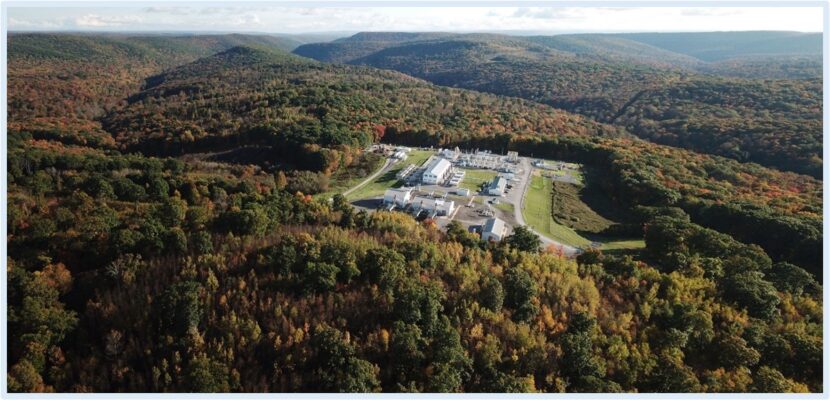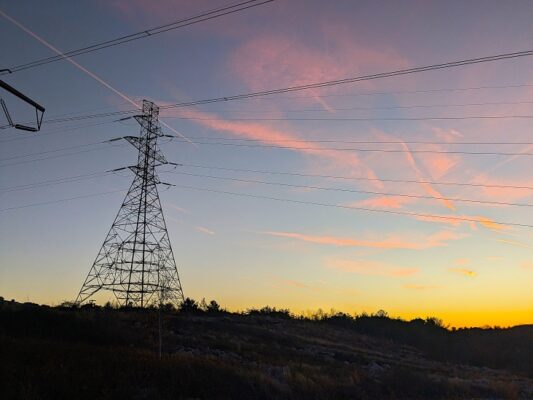by Sam Randall
While driving home from a recent camping trip, I was listening to a podcast titled “A Closer Look At Pennsylvania, The Swingiest of Swing States” and I drove past a perfect, almost comedic example of the swing state election messages the podcasters spoke of: a billboard with an ad for Kamala Harris on the front and an ad for Donald Trump on the back.
With 19 electoral votes, PA is the biggest swing state so of course my fellow Pennsylvanians and I have been inundated with back-to-back political ads on all platforms. In addition to the nonstop ads, we are fed misinformation and disinformation in national conversations about voters in the Keystone State.
Living in Pennsylvania during a presidential election year can feel a bit like Groundhog Day – especially if you care about the environment and the future of clean energy. Once again, the Keystone State finds itself at the center of a national debate about energy policy, and once again, it feels like the only story being told is one of fracking. Fracking, fracking, fracking. It’s like Pennsylvania is synonymous with fossil fuels and nothing else matters.
As a PA resident, I am beyond frustrated by this false narrative.
What’s the Disconnect?
Pennsylvania is an energy-diverse state. Although PA has a long history with coal and fossil gas, it’s also home to growing clean and efficient energy sectors. During election cycles, clean energy opportunities and their associated range of benefits barely get mentioned.
While I have experienced the frenzy of PA’s swing state status during election seasons before, this is the first year I have a professional understanding of energy politics. As a result, I can’t begin to explain just how disheartening it is to hear “Pennsylvania” and “fracking” paired over and over again in headlines and debates.
What is it with national politicians’ obsessive messaging that pairs PA with fracking? While this is just my experience, in over 20 years of living in PA I have never actually met anyone who works directly in the fracking industry. Most people I know don’t even have a strong enough understanding of fracking that it affects their vote.
With a few weeks to go before the election, I decided to take a closer look at the research using three main categories to push back against the false fracking narrative plaguing PA:
Debunk the root of the narrative.
Explore public opinion data of PA residents’ energy views.
Review the data on PA’s energy workforce.
Can the President Even Ban Fracking in PA?
First and foremost – the claim that a U.S. president can simply “ban fracking” across Pennsylvania is misguided at best. Since the September presidential candidates’ debate, fact-checkers have worked to combat misinformation and say that the status of fracking operations cannot be reduced to a simple “ban” or “no ban”. The gist of the reality is that most land that can be fracked in PA is on private land over which the president lacks authority, and most fossil fuel policy is handled at the state – not federal – level. For more information I recommend:
- “Fracking and Politics in Pennsylvania: Assessing the Economic Impact of the Shale Revolution in Pennsylvania”
- “Why Harris and Trump are debating the F-word”
- NRDC “Fracking 101”
It was the comments made about fracking during the September 10th debate in Philadelphia that inspired me to write this blog. Kamala Harris said, “let’s talk about fracking because we are here in Pennsylvania” and then promised not to “ban fracking.” Donald Trump said if Harris becomes president she would “never allow fracking in Pennsylvania” and would end it “on day one.” Both statements reduce a complex topic into a simple action that the president doesn’t actually have the power to enact.
In addition to perpetuating the unnecessary PA/fracking connection, the problem with the oversimplification of their statements is that it clouds any real policy positions regarding energy policy.
What Are Pennsylvanians Actually Thinking About Energy?
From outside the state, it may seem like all Pennsylvanians care about is fossil fuels. As the second-largest net supplier of total energy in the country, it makes sense that energy is emphasized in conversations surrounding PA (EIA).
According to public opinion polling by the Muhlenberg College Institute of Public Opinion in Allentown, the reality is that Pennsylvanians have widely varying views about energy – even fracking. Results from their spring 2022 Pennsylvania Climate and Energy Survey showed that 48% support fossil fuel extraction while 44% oppose it.

Additional recent polling by the Ohio River Valley Institute echoes the older Muhlenberg polls in the divisiveness – showing that 51% of Pennsylvanians support fracking, 30% are opposed, and 19% aren’t sure.
When asked more nuanced questions about climate and energy, Pennsylvanians show additional concern for protecting our natural environment and pursuing clean energy. For example, when asked about the risk fracking poses to public health, 67% of PA residents saw fracking as either a major or minor risk to public health and only 21% responded “no risk” and 13% not sure (2022 PA Climate & Energy Survey).
What Do the Jobs Numbers Say?
The other day while watching Jeopardy! with my parents, a television ad for Republican Senate candidate Dave McCormick presented me with a perfect example of the false narrative being pushed to Pennsylvanians because claims that Harris would cause 300,000+ fracking jobs in Pennsylvania to “disappear.”
This piqued my interest because since the August release of the 2024 U.S. Energy & Employment Jobs Report (USEER) from the Department of Energy, I have been deep in the numbers exploring how many people work in energy jobs across the country and what industries they are working in.
There definitely are not hundreds of thousands of fracking jobs in PA.
While national conversations paint PA as a state dependent on fracking jobs, the USEER data show that PA was actually among the top five states to add the most jobs in energy efficiency (USEER). There are 72,913 Energy Efficiency jobs in PA compared to just 41,523 Fossil Fuel jobs.
While PA may be the nation’s second-largest fossil gas producer, far fewer people work in fossil fuels than in clean energy and energy efficiency.
Keep an eye out for the 2024 Energy Efficiency Jobs in America report (coming soon) for the latest analysis of the EE workforce in PA and across the country!

Conclusion: A Frack-Free Future?
Ultimately, it has been discouraging to see Pennsylvania pigeonholed into an energy narrative that no longer fits. Yes, gas is part of our energy portfolio. But it doesn’t have to be the future, and the data even shows it doesn’t dominate the present – no matter what the presidential campaigns say.
Energy is at the forefront of 2024 election season interests. As a Pennsylvanian and an advocate for clean and efficient energy, the intersection of energy policy and the election – and the dissemination of accurate information about the PA energy landscape – feels particularly important to me.
The PA Climate Action Plan sets the state GHG reduction target of 26% by 2025 and 80% by 2050. Goals like that simply do not leave room for constant fossil fuel fanning.
Moving forward, I hope that instead of “the state that fracks” Pennsylvania can be seen as the innovative, forward-thinking state that it truly is.
Bonus Reading:
Want to learn more about Pennsylvania’s energy landscape? Below are sources I found particularly insightful:
- Research: S. Energy Information Administration: PA State Profile & Energy Estimates
- Article: Polling Shows Pennsylvania Voters Are Divided on Fracking
- Video: Fall 2024 Short Election Briefing on Climate Voters in Pennsylvania
- Article: America’s Biggest Grid Is Losing Its Balance
- Article: Clean Energy Investments Are Revitalizing Pennsylvania Communities, Trump Is Promising to Crush Them
- Press Release: Pennsylvania Voters Strongly Support Significantly Increasing Clean Energy Use
- Article: The Ongoing Struggle to Join PJM’s Grid
–Sam Randall is a Policy Fellow at E4TheFuture
